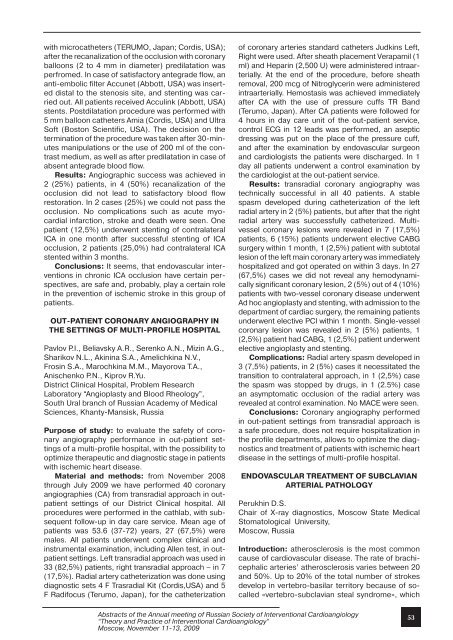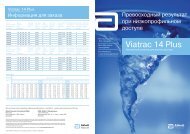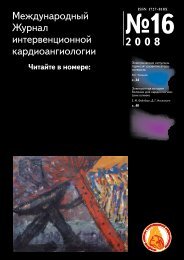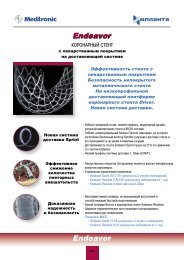Cardiology_english_19_view (1).pdf
Cardiology_english_19_view (1).pdf
Cardiology_english_19_view (1).pdf
- No tags were found...
Create successful ePaper yourself
Turn your PDF publications into a flip-book with our unique Google optimized e-Paper software.
with microcatheters (TERUMO, Japan; Cordis, USA);after the recanalization of the occlusion with coronaryballoons (2 to 4 mm in diameter) predilatation wasperfromed. In case of satisfactory antegrade flow, ananti-embolic filter Accunet (Abbott, USA) was inserted distal to the stenosis site, and stenting was carried out. All patients received Acculink (Abbott, USA)stents. Postdilatation procedure was performed with5 mm balloon catheters Amia (Cordis, USA) and UltraSoft (Boston Scientific, USA). The decision on thetermination of the procedure was taken after 30-minutes manipulations or the use of 200 ml of the contrast medium, as well as after predilatation in case ofabsent antegrade blood flow.Results: Angiographic success was achieved in2 (25%) patients, in 4 (50%) recanalization of theocclusion did not lead to satisfactory blood flowrestoration. In 2 cases (25%) we could not pass theocclusion. No complications such as acute myocardial infarction, stroke and death were seen. Onepatient (12,5%) underwent stenting of contralateralICA in one month after successful stenting of ICAocclusion, 2 patients (25,0%) had contralateral ICAstented within 3 months.Conclusions: It seems, that endovascular interventions in chronic ICA occlusion have certain perspectives, are safe and, probably, play a certain rolein the prevention of ischemic stroke in this group ofpatients.OUT-PATIENT CORONARY ANGIOGRAPHY INTHE SETTINGS OF MULTI-PROFILE HOSPITALPavlov P.I., Beliavsky A.R., Serenko A.N., Mizin A.G.,Sharikov N.L., Akinina S.A., Amelichkina N.V.,Frosin S.A., Marochkina M.M., Mayorova T.A.,Anischenko P.N., Kiprov R.Yu.District Clinical Hospital, Problem ResearchLaboratory “Angioplasty and Blood Rheology”,South Ural branch of Russian Academy of MedicalSciences, Khanty-Mansisk, RussiaPurpose of study: to evaluate the safety of coronary angiography performance in out-patient settings of a multi-profile hospital, with the possibility tooptimize therapeutic and diagnostic stage in patientswith ischemic heart disease.Material and methods: from November 2008through July 2009 we have performed 40 coronaryangiographies (CA) from transradial approach in outpatientsettings of our District Clinical hospital. Allprocedures were performed in the cathlab, with subsequent follow-up in day care service. Mean age ofpatients was 53.6 (37-72) years, 27 (67,5%) weremales. All patients underwent complex clinical andinstrumental examination, including Allen test, in outpatientsettings. Left transradial approach was used in33 (82,5%) patients, right transradial approach – in 7(17,5%). Radial artery catheterization was done usingdiagnostic sets 4 F Trasradial Kit (Cordis,USA) and 5F Radifocus (Terumo, Japan), for the catheterizationof coronary arteries standard catheters Judkins Left,Right were used. After sheath placement Verapamil (1ml) and Heparin (2,500 U) were administered intraarterially. At the end of the procedure, before sheathremoval, 200 mcg of Nitroglycerin were administeredintraarterially. Hemostasis was achieved immediatelyafter CA with the use of pressure cuffs TR Band(Terumo, Japan). After CA patients were followed for4 hours in day care unit of the out-patient service,control ECG in 12 leads was performed, an asepticdressing was put on the place of the pressure cuff,and after the examination by endovascular surgeonand cardiologists the patients were discharged. In 1day all patients underwent a control examination bythe cardiologist at the out-patient service.Results: transradial coronary angiography wastechnically successful in all 40 patients. A stablespasm developed during catheterization of the leftradial artery in 2 (5%) patients, but after that the rightradial artery was successfully catheterized. Multivesselcoronary lesions were revealed in 7 (17,5%)patients, 6 (15%) patients underwent elective CABGsurgery within 1 month, 1 (2,5%) patient with subtotallesion of the left main coronary artery was immediatelyhospitalized and got operated on within 3 days. In 27(67,5%) cases we did not reveal any hemodynamically significant coronary lesion, 2 (5%) out of 4 (10%)patients with two-vessel coronary disease underwentAd hoc angioplasty and stenting, with admission to thedepartment of cardiac surgery, the remaining patientsunderwent elective PCI within 1 month. Single-vesselcoronary lesion was revealed in 2 (5%) patients, 1(2,5%) patient had CABG, 1 (2,5%) patient underwentelective angioplasty and stenting.Complications: Radial artery spasm developed in3 (7,5%) patients, in 2 (5%) cases it necessitated thetransition to contralateral approach, in 1 (2,5%) casethe spasm was stopped by drugs, in 1 (2.5%) casean asymptomatic occlusion of the radial artery wasrevealed at control examination. No MACE were seen.Conclusions: Coronary angiography performedin out-patient settings from transradial approach isa safe procedure, does not require hospitalization inthe profile departments, allows to optimize the diagnostics and treatment of patients with ischemic heartdisease in the settings of multi-profile hospital.ENDOVASCULAR TREATMENT OF SUBCLAVIANARTERIAL PATHOLOGYPerukhin D.S.Chair of X-ray diagnostics, Moscow State MedicalStomatological University,Moscow, RussiaIntroduction: atherosclerosis is the most commoncause of cardiovascular disease. The rate of brachicephalic arteries’ atherosclerosis varies between 20and 50%. Up to 20% of the total number of strokesdevelop in vertebro-basilar territory because of socalled«vertebro-subclavian steal syndrome», whichAbstracts of the Annual meeting of Russian Society of Interventional Cardioangiology“Theory and Practice of Interventional Cardioangiology”Moscow, November 11-13, 200953
















